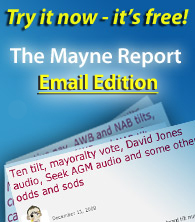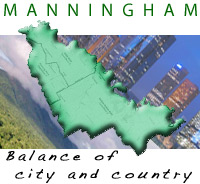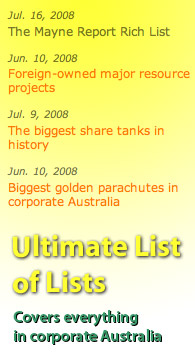Brit's show the way, Snowy float, B&B pay bonanza and Oxiana facts
July 22, 2008
Here are Stephen Mayne's four stories from the Crikey edition on Wednesday, April 26, 2006.
5. Brits show the way on campaign finance
By Stephen Mayne
Peter Phelps, the Howard Government's chief defender of Australia's weak and getting weaker political funding and disclosure laws, has been noticeably silent since I answered his challenge and laid out a workable campaign finance model last Friday (item 11) in Crikey.
The proposal borrowed in part from the best aspects of the UK system, which has today been demonstrated in the Australian press with reports about Lynton Crosby's tidy $1.1 million consultancy for seven months' work for the Tories on last year's British election campaign. The Brits even have to disclose that Liberal Democrats leader Charles Kennedy spent almost $20,000 on make-up and six suits.
Of course, our political parties don't have to publicly release a breakdown of their spending, something the Brits have to do as part of the 18 million pound spending limits they also have in place to prevent elections from being bought.
Sure, it must add to the administrative burden but less than 12 months after last year's 5 May general election, the public has been told who funded the campaign and how the money was spent. Check out the Labour Party breakdown on media, advertising, flyers, events, transport and market research across England, Wales and Scotland here. The Tory equivalent is here.
Compare that with Australia and our last federal election on 9 October, 2004. It took almost 16 months before we got the deluge of indecipherable political donations figures in 2004-05 for the Commonwealth, all states and territories dumped on the AEC website at 9am on 1 February, 2006. Sadly, there was no breakdown of loans – something the Brits have to disclose – and no detail whatsoever on how all the money was spent.
As we've said before, our political parties don't even have to make their audited accounts public. The Brits certainly do. Check out the 2004 annual return for the Liberal Democrats here. It shows a detailed breakdown of the 4.09 million pounds of revenue, the 4 million pounds of expenses and we even get a balance sheet, showing net assets of 691,705 pounds.
The Labour Party return shows revenue of 29.3m in 2004 but the party recorded a loss of 2.8m and its net deficiency blew out to 6.4m. The ALP is certainly in far better shape, although my estimate that the great unions-ALP conglomerate has net assets of about $500 million is nothing more than a guess because there is no disclosure requirement.
By 30 June we'll have all the audited profit and loss statements and balance sheets for British political parties as at 31 December 2005 – six months after the financial year close. Whilst my kinder has to tell the Bracks government its net assets each year, I'm still yet to hear any argument, or even an attempted defence, of our political parties not having to do this.
C'mon Mr Phelps, surely you're prepared to go another round on this point. Why doesn't your current bill introduce balance sheet disclosure, rather than just shafting young voters by closing the electoral roll early, increasing political welfare through greater tax deductibility of donations and reducing accountability by lifting the disclosure threshold for donations from $1,500 to $10,000?
6. Time for a rain check on the Snowy float
By Stephen Mayne
As Morris Iemma sprints towards his treasured June budget boost Advertisement
courtesy of the $3 billion Snowy Hydro float, it is worth considering a few key issues that need to be resolved.
Firstly, Victorian Premier Steve Bracks no doubt remembers that Gippsland East MP Craig Ingram was one of the three independents who delivered him government in October 1999. The price of Ingram's support was a written commitment from both the Victorian and NSW Governments to increase the long-term flow down the Snowy River to 28% or 330 gigalitres.
At the time it was running at less than 1% or just 9 gigalitres, but this has now risen to 6% and all sides have agreed that a target of 21% will be reached by 2012. This means the key issue remains the compensation that will flow to a privatised Snowy Hydro in achieving that final increase from 21% to 28% after 2012.
Whilst Snowy Hydro is owned by the NSW, Victorian and Federal governments, such an increase in flows is merely another political decision, albeit one that might reduce profits and dividends returning to the government shareholders. However, once it's privatised, the profit-motivated listed company would have to seek compensation under the terms of its secret 72-year water licence which requires nothing more than 21% by 2012. Surely a publicly available water licence for no more than 25 years would be more appropriate to retain some long term flexibility for public policy planning.
Craig Ingram has every right to feel that he's being sold down the river on the long term commitment to hit a 28% flow and the Bracks Government would be wise to seek his input into the prospectus. After all, a legal challenge is the last thing the sellers would want but Ingram is clearly fired up over this issue.
Ingram received a primary vote of 24.79% in 1999 and 41.33% in 2002 and he'll get plenty of oxygen over the Snowy float to boost his chances of winning a third term at this year's poll. In fact, the new proportional representation voting system in the upper house could see Ingram back his own candidate and deliver a like-minded independent to share in the balance of power with minor parties, most probably the Greens.
Privatising sensitive assets without consulting key stakeholders is exactly the sort of thing the Kennett Government used to do. Country voters hated the arrogance, yet the most powerful political journalist in Victoria, The Age's Paul Austin, delivered this stinging critique last Friday of the Bracks Government's own Kennettesque record on parliamentary accountability.
The Sunday Age also claimed that it's actually Treasurer John Brumby who runs Victoria and he's certainly the one calling the shots on this wall of secrecy surrounding the Snowy Hydro float. Maybe it's time the Premier took an interest after his latest overseas trip and started by having a chat to Craig Ingram.
22. How did the press miss Babcock's pay bonanza?
By Stephen Mayne, small but enthusiastic Babcock & Brown shareholder
Let's first deal with the correction. My three reports in the previous edition of Crikey about Babcock & Brown's annual report were wrong in terms of the time of lodgement – it was 12.54pm Friday, not Monday morning. The blunder was partly because I didn't know what day it was, but also because I didn't believe it was possible all the major media outlets would have missed such a big story for three days.
In what is a sad reflection on the state of business journalism in Australia, it seems that keeping tabs on ASX announcements is not something that happens on a Friday afternoon any more. This is how the story of Babcock & Brown's extraordinary 2005 pay packages unfolded.
Friday: Annual report and notice of meeting for AGM lodged with ASX at 12.54pm. Missed by all wire services and supposedly fast online providers covering breaking news.
Saturday: No coverage in any Saturday paper, including The AFR, which wasn't to come out again until Wednesday.
Sunday: No mention on the two weekend TV business shows and nothing in the Sunday papers.
Monday: Still no coverage in the papers, but Crikey publishes three stories at 1.24pm after physically receiving two copies of the annual report as a shareholder that morning.
Tuesday: The Australian publishes a report with a very similar tone and line to Crikey and The Age also follows up in its gossip column.
Wednesday: The SMH belatedly puts it on the record but The AFR still fails to mention it.
Does anyone remember the major public debate that erupted last May when Macquarie Bank's 2004-05 salary figures were released? It was front page news because the top seven executives shared $89 million and even Peter Costello publicly questioned it. Fast forward 12 months and the second biggest pay bonanza ever released – $55.8 million for the top seven – by an Australian-based company is completely ignored.
Here is a table which lines up the biggest pay packets at Macquarie Bank and Babcock & Brown. Macquarie won't release its first top ten until its full year results on 18 May, which is why we only have 17 names on the list.
| Name | Position | Latest annual pay |
| 1. Allan Moss | CEO Macquarie Bank | $18.5m |
| 2. Nicholas Moore | Macquarie investment banking boss | $18.22m |
| 3. Bill Moss | Macquarie property boss | $15.4m |
| 4. Phil Green | Babcock CEO | $12.18m |
| 5. Ottmar Weiss | Macquarie commodities boss | $11.5m |
| 6. Andrew Downe | Macquarie treasury boss | $10.4m |
| 7. Michael Maxwell | Babcock property boss | $10.06m |
| 8. David Clarke | Macquarie chairman | $9.8m |
| 9. Peter Hofbauer | Babcock infrastructure boss | $9.44m |
| 10. Martin Rey | Babcock Europe boss | $7.03m |
| 11. Steven Zissis | Babcock aircraft leasing boss | $5.73m |
| 12. David Ross | Babcock chief operating officer | $5.64m |
| 13. Robert Topfer | Babcock corporate finance boss | $5.09m |
| 14. Richard Sheppard | Macquarie deputy MD | $4.8m |
| 15. James Babcock | Babcock executive chairman | $4.62m |
| 16. Daniel Brickman | Babcock structured finance boss | $4.47m |
| 17. James Fantaci | Babcock US and leasing boss | $4.41m |
Macquarie clearly pays more at the very top. However, Babcock has eight of the top 15. The annual report shows that Babcock averaged $768,248 across its average 2005 staff number of 548, yet The SMH trumpeted last May that Macquarie averaged $185,936 across its 6,556 staff in 2004-05.
So here we have a tale about the most generous and lucrative employer in the country lodging a document with the ASX and it completely passes the mainstream media by. Sad, isn't it. Back to Top
26. Putting all the Oxiana facts on the table
By Stephen Mayne, small Oxiana shareholder
I've been taking some email stick and getting flogged on the odd website for last Friday's criticisms of the Oxiana "options rort". This is from a Crikey subscriber:
I need to take issue with you regarding the "options rort" in CEO Owen Hegarty's remuneration at Oxiana Ltd. I think you are wrong – both technically and morally, and it would be helpful if you issued an apology. Hegarty is a folk hero amongst the loyal shareholders – all of whom are mighty p*ssed off with you.And then there was this on the ShareScene website:
Oxiana have always been very approachable, both now in the ASX 100 and years back when they were tiny. I don't know why those complaining just didn't pick up the phone and ask for an explanation as I did. As for that tosser Mayne, he too could have simply rung the company to ask for an explanation. But no, he prefers his grandstanding to grab his ten seconds of fame.Sadly, it seems those who have profited from investing in Oxiana have been blinded by their newfound riches. Let's now look at the facts. Hegarty was issued 4 million options to buy shares at $1.20 a piece at the 2004 AGM, but the notice of meeting only stated that "the options will vest on 1 June 2006, subject to the satisfaction of performance hurdles".
The subsequent 2004 annual report, released in March 2005, clarified that the hurdles were as follows:
- 50% will vest on 1 June 2006 if the total shareholder return of Oxiana for the year ended June 30, 2005 exceeds the median of the total shareholder return of competitor companies.
- a further 50% will vest on 1 June 2006 if the total shareholder return of Oxiana for the year ended 30 June 2005 is in the top quartile of the total shareholder return of competitor companies.
- 50% will vest on 1 June 2006 if the total shareholder return of Oxiana for the two years ended 31 December 2005 exceeds the median of the total shareholder return of comparator companies;
- a further 50% will vest on 1 June 2006 if the total shareholder return of Oxiana for the two years ended 31 December 2005 is in the top quartile of the total shareholder return of comparator companies.
The board has every right to feel sorry for Hegarty and could easily have given him a bigger cash bonus as compensation. However, he does own 27 million ordinary shares and a further 2 million $1.20-a-share options that were issued in 2005 and are well in the money with all hurdles set to be easily surpassed.
This is an issue all about the specific 4 million options and the performance hurdles that were changed from the 2004 annual report to the 2005 annual report. The facts are not in dispute and Oxiana is yet to publicly clarify the situation.
Institutional Shareholders Services, the world's most powerful proxy advisor, approached Oxiana for an explanation almost three weeks before the AGM. Private mutterings about a "mistake" never materialised into a public statement, so ISS recommended a vote against the remuneration report and the big institutions did just that, delivering a stunning 46% against vote – the biggest of any top 100 company.
Rather than attacking me, ISS and the institutions, Oxiana should have a good look at itself and its cheer squad of small shareholders should apprise themselves of all the facts outlined in this item and then dismount their high horses. Besides, why should shareholders be so keen to give away $8.8 million of value that they don't have to. If the company is feeling so generous, perhaps they could donate an extra $8.8 million to help Laos, the third world country which has delivered more than half of the $4.5 billion in shareholder value to Oxiana. Back to Top
Copyright © 2024 The Mayne Report. All rights reserved






















